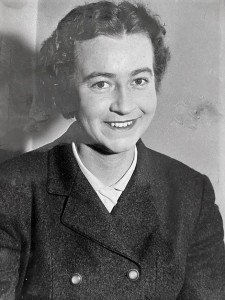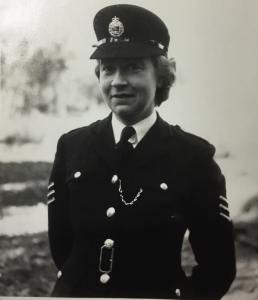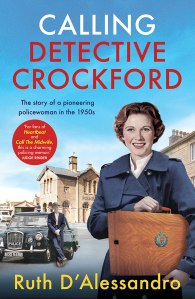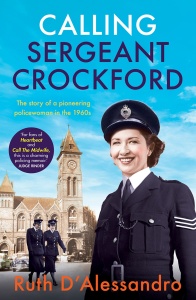“The Incredible Story of 1950s Policewoman Gwen Crockford –
One of the UK’s First Woman Detectives”
by
Ruth D’Alessandro
How does an author write three books about her amazing, pioneering policewoman mother when all she has to go on is remembered stories and anecdotes? Surely police forces keep detailed historical archives of their personnel? Unfortunately not. In Ruth D’Alessandro’s case, research was king, making her trilogy all the richer for her thousands of hours of hard work.

When Ruth D’Alessandro was researching her trailblazing mum’s 1950s/60s police career through Sulhamstead House police training school archives and the Berkshire Record Office, the only reference to the Berkshire Constabulary’s first ever woman detective was a note saying, “a medical had taken place.” A pioneering, eleven-year career as a WPC, detective, and woman sergeant, reduced to a mere tick box in a dusty archive – not even a footnote.
This made Ruth even more determined to find out more about what her mum did in the British postwar provincial police. Gwen sadly died in 2004, but left a small file of papers, newspaper clippings, and a few photographs. More importantly, though, she left her stories that she had told many times over the years seared into Ruth’s memory.
The more Ruth researched her mum’s story using out-of-print books, journals, academic papers, online forums, and original Berkshire newspapers of the time held in London’s famous British Library, the more she discovered how little was written about policewomen in the 1950s. It’s almost as if they have been airbrushed out of history. So Ruth uncovered the following revelations about her mum. And then she started writing.
Gwen’s Early Life
Gwen Crockford was nine when World War Two broke out. Although rural Wokingham in Berkshire where she was born and brought up did not receive the same pounding by the Luftwaffe that London did, it was a frightening time. The Crockfords contended daily with the threat of Nazi invasion, air raid sirens, the blackout, rationing, going to bed hungry, “make do and mend,” neighbours’ sons going off to war, and memories of the dreadful First World War still fresh in their minds.
Gwen left school in December 1943 and went to work at a sawmill office in Sunningdale. Cheerful Italian prisoners of war, happy to be out of the conflict, skipped about among the whining, industrial circular saws that chomped colossal tree trunks. One POW even sent her a beautifully written proposal of marriage, which she politely declined as she was fifteen.
After the sawmill job, Gwen took evening classes in secretarial work and went to work as a shorthand typist in a solicitors’ office opposite the imposing Wokingham Police Station in Rectory Road. Seated at her typewriter by an upstairs window, Gwen looked out over the station’s comings and goings and found them far more interesting than the tedious legal documents she was supposed to be typing. As luck would have it, in the early 1950s the Berkshire Constabulary was encouraging more women to join the ranks. Gwen applied to the police in 1951 and was accepted onto the thirteen weeks of training at Mill Meece Training School in Staffordshire.
WPC Crockford

Passing out as a WPC (Woman Police Constable) kick-started Gwen’s astonishing eleven-year career in the county police, an almost unheard-of length of service for a woman in those days (the average was four years). As a WPC, Gwen did similar work to the men (except night duty and being sent to particularly dangerous or physically demanding incidents), but with added responsibilities around women and children. Every day would bring something new and challenging: she could be investigating a shop-breaking, attending an autopsy, checking animal health at a cattle market, finding a lost toddler, giving someone a parking notice, or removing neglected and mistreated children from home, under the Children and Young Person’s Act. In 1952, Gwen was on duty when infamous serial child murderer John Straffen escaped from Broadmoor Hospital to murder little Linda Bowyer in the four hours he was out. Then, in 1955, she was patrolling Ascot Races on the day of the deadly lightning strikes that killed two people and injured forty-nine.
However, it was her pioneering work around interviewing children from an abusive home and bringing the perpetrator to justice that really got her noticed by the Berkshire Constabulary’s higher echelons.
Woman Detective Constable Crockford
Gwen was selected for detective training at London’s Hendon police college, one of only two women in her class of twenty-eight officers drawn from the Metropolitan and City of London Police and the southern provincial forces. Her training included attending an autopsy with renowned Home Office pathologist Dr Keith Simpson, investigating a murder scene with a dummy named “Mary, the Met’s Most Murdered Mannequin,” learning ballistics, forensics, fingerprint techniques, and a lot of law. She passed with flying colours, returning briefly to Wokingham and Newbury as a WPC while waiting for a detective constable position to become vacant, which it did 1957. WPC Crockford became WDC Crockford, the first woman in the Berkshire Constabulary to be made a detective, covering both Maidenhead and Windsor police stations.
A woman in a man’s CID world, rubbing shoulders with eminent pathologists and with a hotline to Scotland Yard and the Metropolitan Police Forensic Science Laboratory, Gwen was at the cutting-edge of 1950s forensic police investigation. Much of that would seem primitive – and unthinkable – today: it was a criminal offence for men to have gay relationships and for a person to commit, or attempt to commit, suicide. Gwen’s remit covered both those historic felonies, and much more.
It was notoriously difficult to advance a career in CID – hard enough for men, harder still for a woman. Following several distressing CID cases, and a change of leadership, Gwen decided to apply for promotion back into uniform where she felt she naturally belonged – preventing such crimes, rather than picking up the pieces afterwards.
Woman Police Sergeant Crockford

In 1960, after passing her sergeant’s exams, newly promoted WPS Crockford was sent to Newbury in rural West Berkshire – the town at heart of Britain’s atomic weapons programme – when the Cold War was at its height. Greenham Common US air force base and the AWRE (Atomic Weapons Research Establishment) were on the doorstep. The burgeoning CND movement organised the annual Aldermaston protest marches, a major part of the Berkshire Constabulary’s policing calendar.
Initially worried that her posting to the Pelican Lane station in Newbury would be boring and provincial, Sergeant Gwen and her two capable WPCs found themselves busier than ever with challenging cases: a serial sex attacker on the loose, an attempted murder at the US air force base, a charismatic heiress with a family secret living in a run-down mansion, and a shocking discovery in a railway station lavatory kept these three bright young officers busy.
After more than a decade of dealing with numerous horrors involving babies and children, with zero psychological support, Gwen decided that she had seen enough of the worst of humanity. She was ready to hand in her warrant card. Previously resigned to the single life, her developing friendship with a nature-loving war veteran PC at Newbury station helped her make the decision. In May 1962 she left the police for good.
The Crockford Trilogy
The above is just an outline of Gwen Crockford’s remarkable pioneering police career. Ruth has taken all her mum’s stories and her own research, and combined them into a trilogy of three books about her mum: Calling WPC Crockford, Calling Detective Crockford, and Calling Sergeant Crockford, published by Welbeck/Headline. If you’d like to read much more about this remarkable woman who helped pave the way for modern policewomen in both Britain and abroad, immersing yourself in the social history of the time, the trilogy is available online, from bookshops, and your local library as paperbacks, ebooks and audiobooks. You can order from Amazon here from the States for these books and here in the U.K.
  
Ruth D’Alessandro is an author and journalistic copywriter with a special interest in post-war social  history, especially policing. This fascination comes from being the daughter of police parents. Her mother, Gwendoline Crockford, detailed above, was one of the early 1950s WPCs in the Berkshire Constabulary, as well as its first woman detective in 1957. Her father, Sgt Jack Hutson served with the UK’s Thames Valley Police until 1975. history, especially policing. This fascination comes from being the daughter of police parents. Her mother, Gwendoline Crockford, detailed above, was one of the early 1950s WPCs in the Berkshire Constabulary, as well as its first woman detective in 1957. Her father, Sgt Jack Hutson served with the UK’s Thames Valley Police until 1975.
Photos of Gwen Crockford and book covers from Ruth D’Alessandro; Photo of Ruth from her Amazon author page.
|